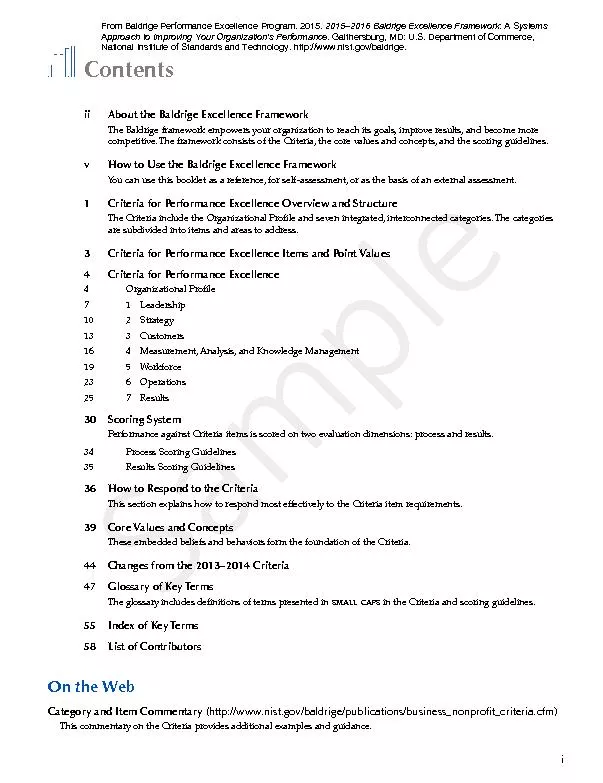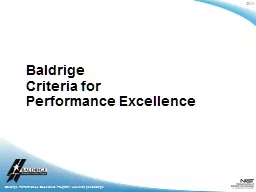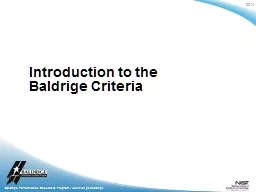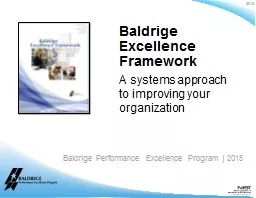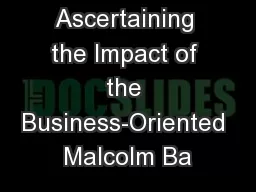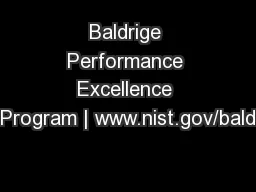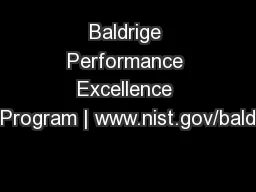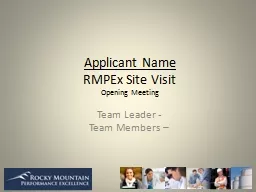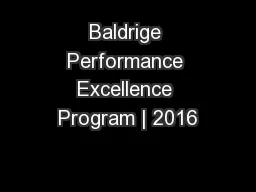PDF-About the Baldrige Excellence Framework
Author : tawny-fly | Published Date : 2016-03-22
iContents ii The Baldrige framework empowers your organization to reach its goals improve results and become more v How to Use the Baldrige Excellence Framework You
Presentation Embed Code
Download Presentation
Download Presentation The PPT/PDF document "About the Baldrige Excellence Framework" is the property of its rightful owner. Permission is granted to download and print the materials on this website for personal, non-commercial use only, and to display it on your personal computer provided you do not modify the materials and that you retain all copyright notices contained in the materials. By downloading content from our website, you accept the terms of this agreement.
About the Baldrige Excellence Framework: Transcript
iContents ii The Baldrige framework empowers your organization to reach its goals improve results and become more v How to Use the Baldrige Excellence Framework You can use this booklet as a refere. 2013–2018. Futurescan. 1. Futurescan. Co-sponsored by:. Society for Healthcare Strategy and Market Development of the American Hospital Association . American College of Healthcare Executives. With Support From VHA Inc.. www.nist.gov. /baldrige. Baldrige. Criteria . for . Performance . Excellence. Criteria Categories. Leadership. Strategic Planning. Customer Focus. Measurement, Analysis, and Knowledge Management. Workforce Focus. Baldrige Performance Excellence Program | www.nist.gov/baldrige. It . amazes me that U.S. businesses spend so much money on . “how-to” . books and . course work . to teach leaders how to build successful organizations. . Baldrige Excellence Framework. A systems approach to improving your organization. The Baldrige Criteria challenged us to become leaders by any measure, and we succeeded—seeing . productivity, customer loyalty, employee engagement, and financial returns. From the Voices of Educational Leaders . Ned D. Young, Ph.D. . Sinclair Community College . Dayton, OH 45402 . ned.young@sinclair.edu. Malcolm Baldrige National Quality Award (MBNQA). Established 1987 by the National Institute for Standards and Technology (NIST). 2011. Judge’s Survey of 2010 Applicants for the MBNQA. Judge’s Meeting. June 14, 2011. Quick Reminder on Methodology. . Electronic survey sent to OCP 30 days after mailing of feedback report. Change in survey design in 2009 to NPS like questions with follow-up . Performance Excellence: . A . Systems Approach and . Tools. Higher . productivity. Greater customer loyalty . Increased market share. Improved . profitability. Better . employee relations . Baldrige . RM. PEx . Site . Visit. Opening Meeting. Team Leader -. Team Members – . What is Rocky Mountain Performance Excellence (. RM. PEx)?. A self-supporting, 501c3 non-profit volunteer (~100) organization, affiliated with the Malcolm . Baldrige Excellence Framework. A systems approach to improving your organization. The Baldrige Criteria challenged us to become leaders by any measure, and we succeeded—seeing . productivity, customer loyalty, employee engagement, and financial returns. More than L.I.P. S.E.R.V.I.C.E. at Arête Schools!. A lifetime of excellence begins at Arête Schools!. L. ead. . Lead with a relentless pursuit of the highest levels of student learning and success.. Jonathan Plucker. May 20, . 2014. EWA National Symposium. Nashville, Tennessee. The 21. st. century. The 21. st. Century …. … is clearly proving to be a brave new world where skills and talents that previously helped us achieve success need to be rethought.. TNCPE . Overview for . 2017 . Applicants. Opening Meeting Agenda. Introductions . Applicant presentation. TNCPE presentation. TNCPE Overview. Purpose of the Site . V. isit. Role of Examiners. Confidentiality and Code of Conduct. 101. Employee. Development Day – Sept. 29, 2010. What is the Malcolm . Baldrige. National Quality Award?. An . assessment tool . for understanding organizational strengths and opportunities for improvement. . La gamme de thé MORPHEE vise toute générations recherchant le sommeil paisible tant désiré et non procuré par tout types de médicaments. Essentiellement composé de feuille de morphine, ce thé vous assurera d’un rétablissement digne d’un voyage sur .
Download Document
Here is the link to download the presentation.
"About the Baldrige Excellence Framework"The content belongs to its owner. You may download and print it for personal use, without modification, and keep all copyright notices. By downloading, you agree to these terms.
Related Documents

